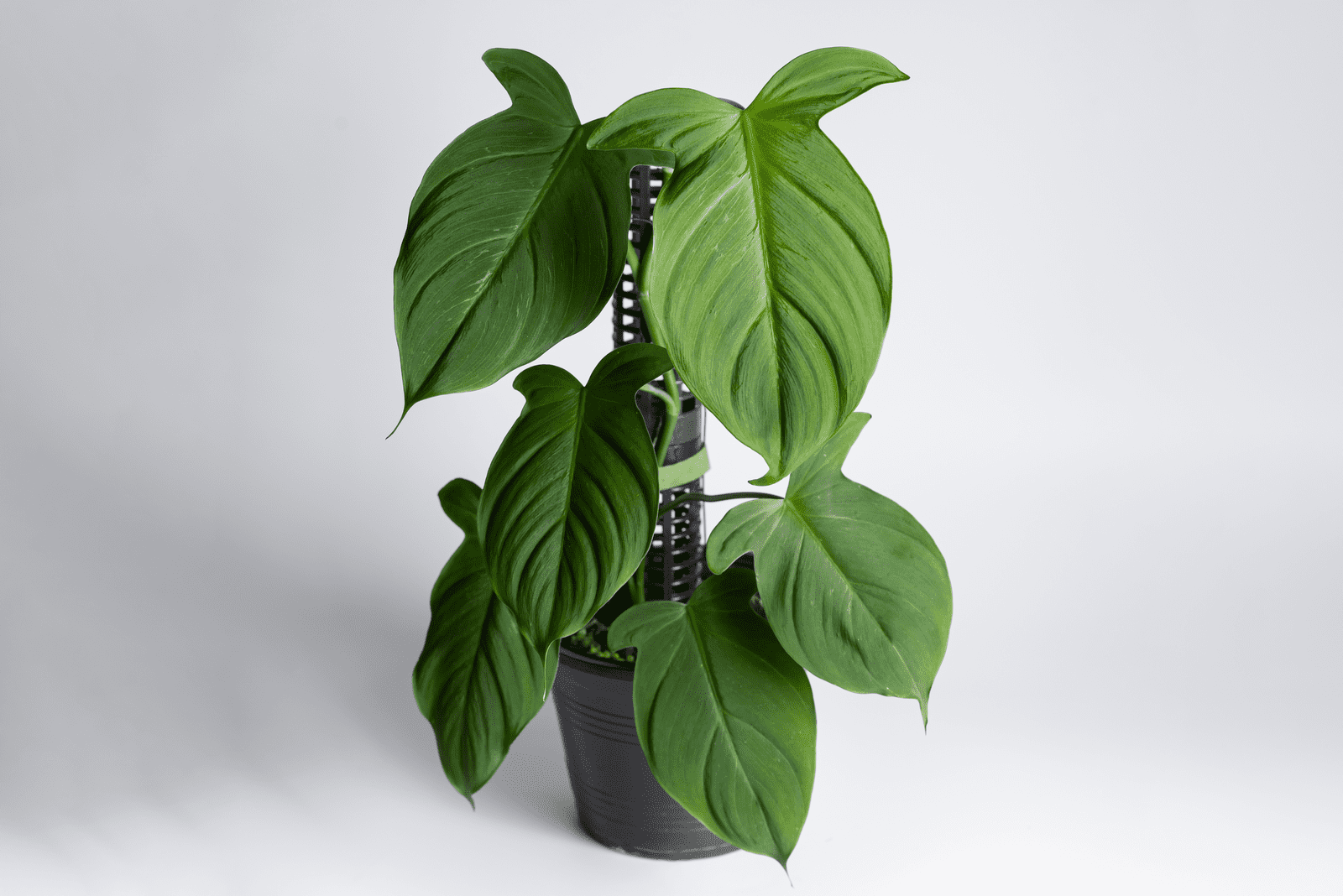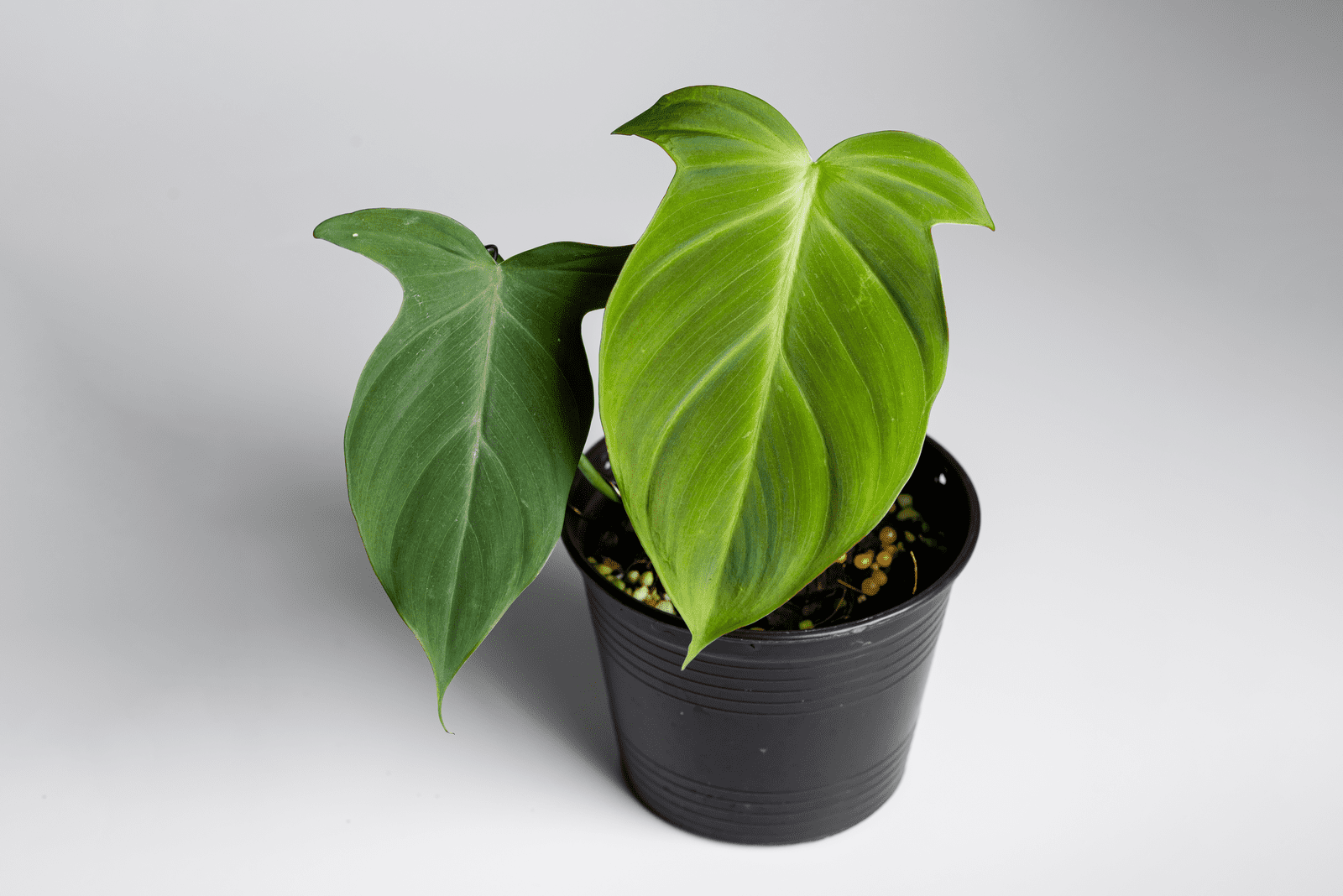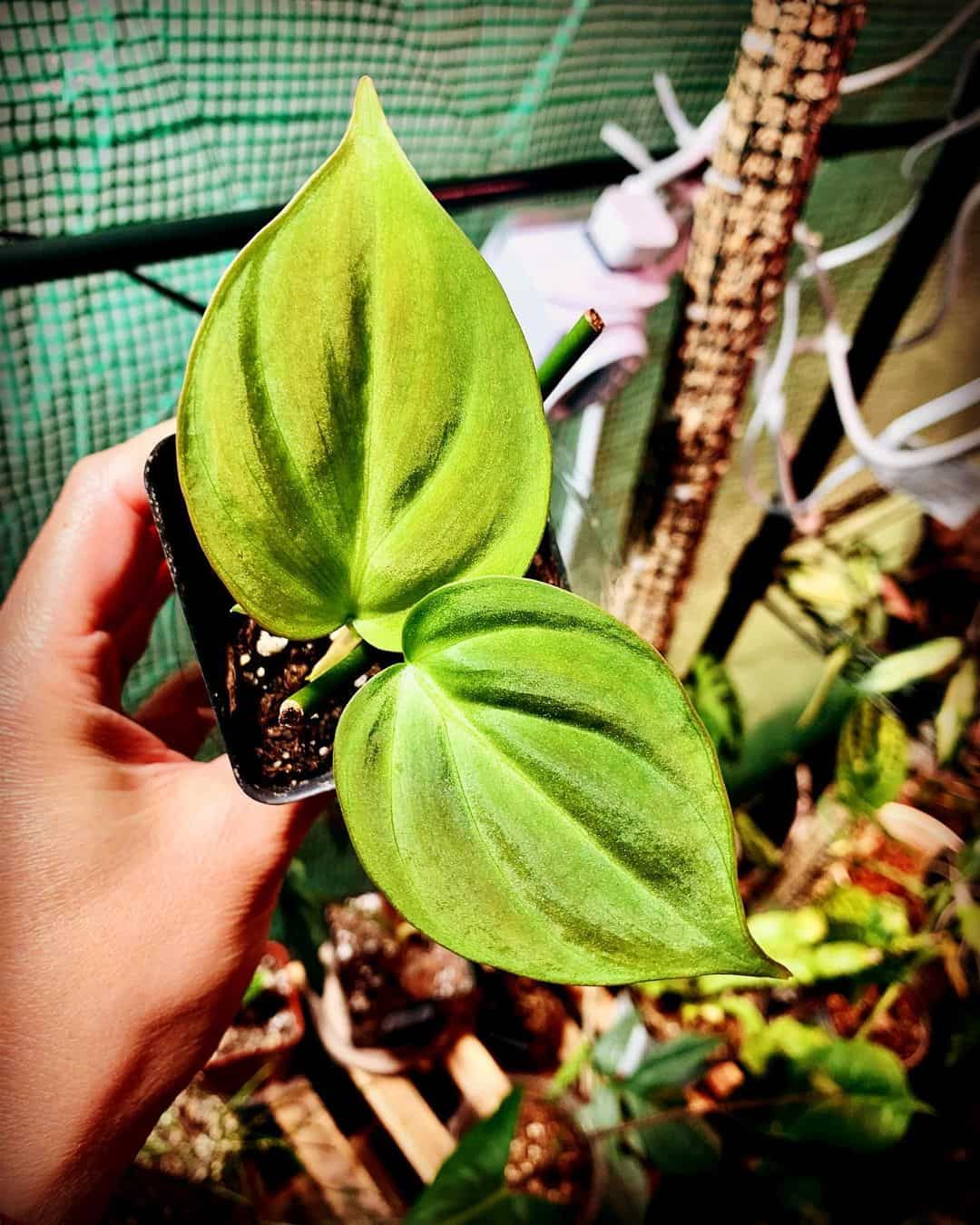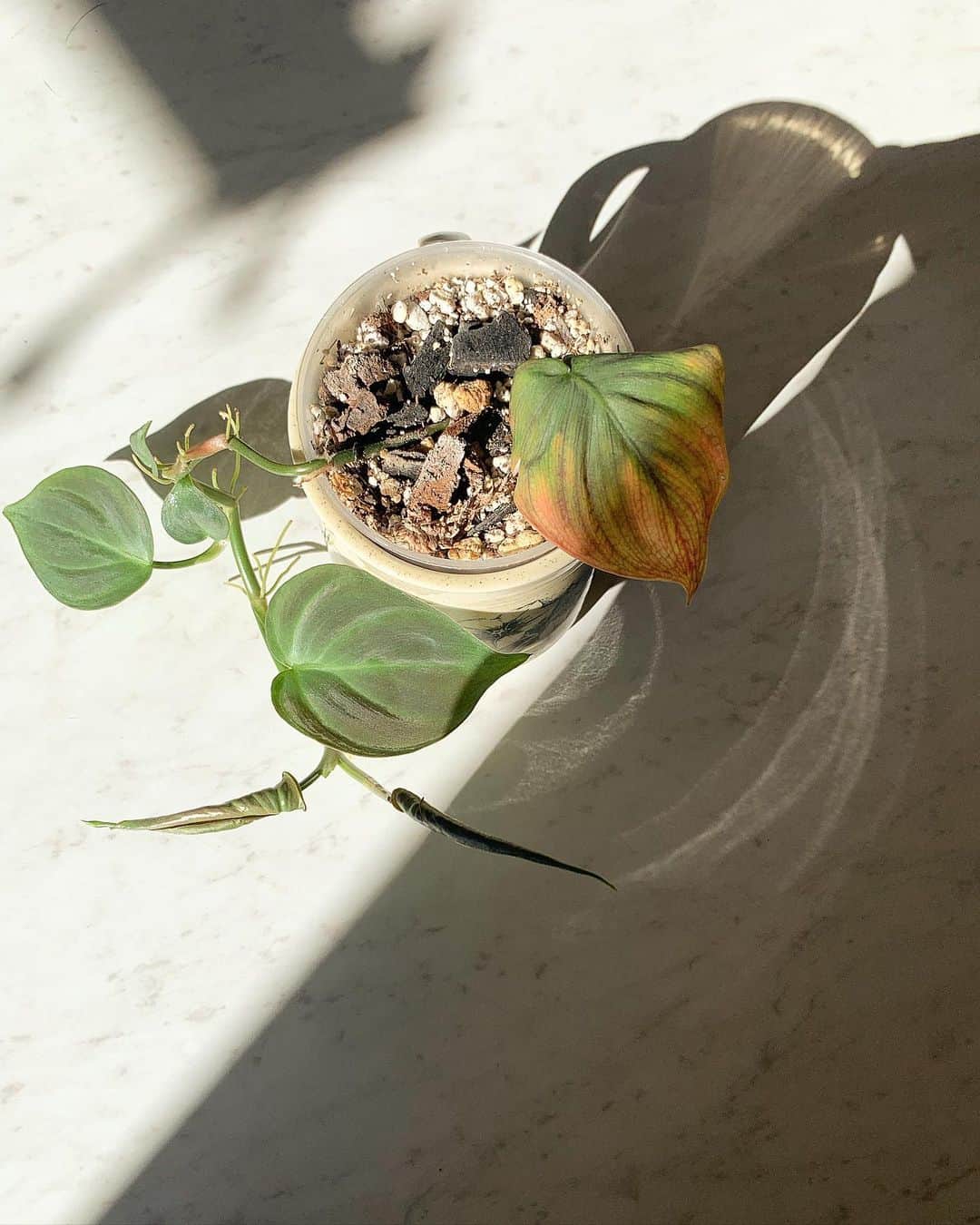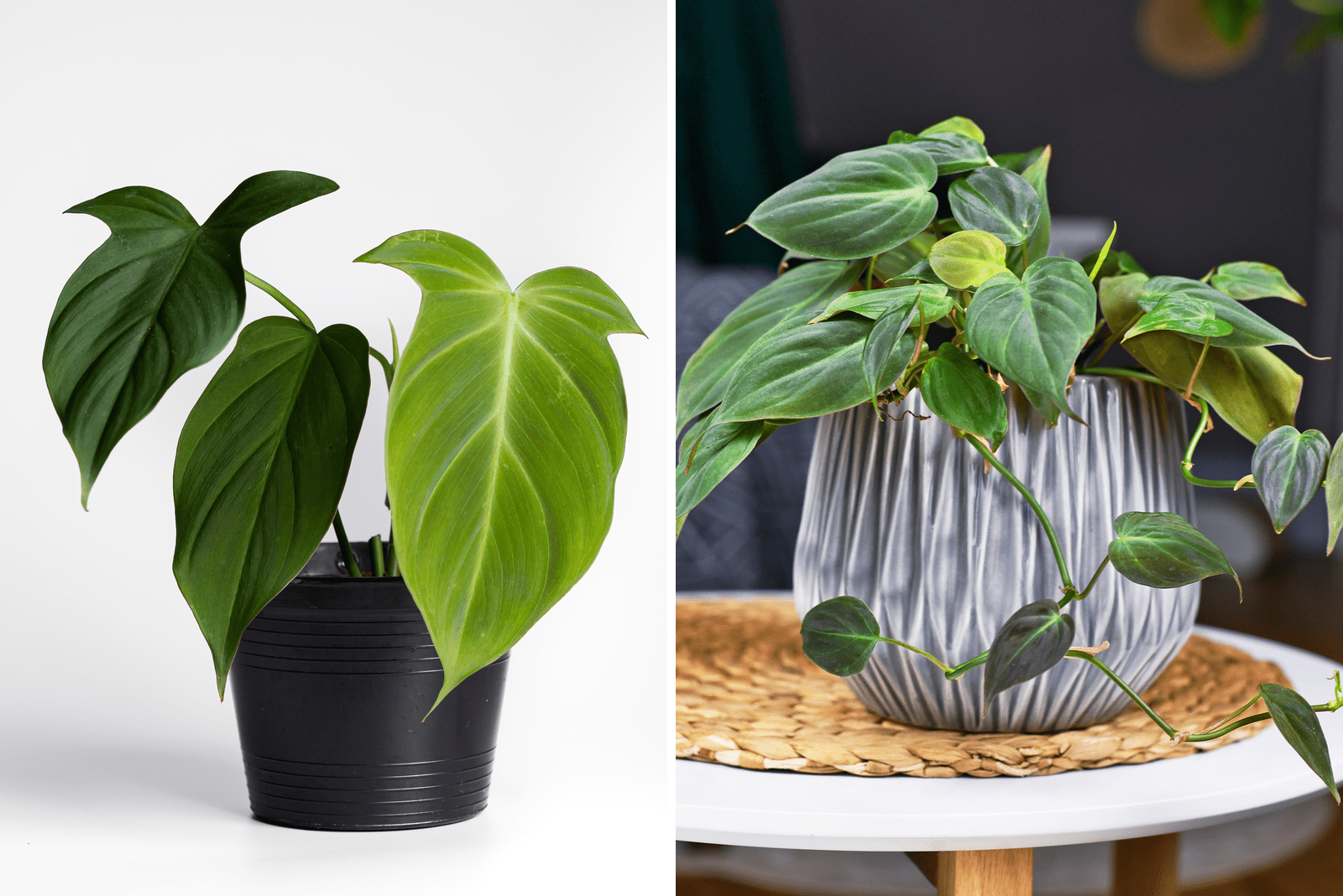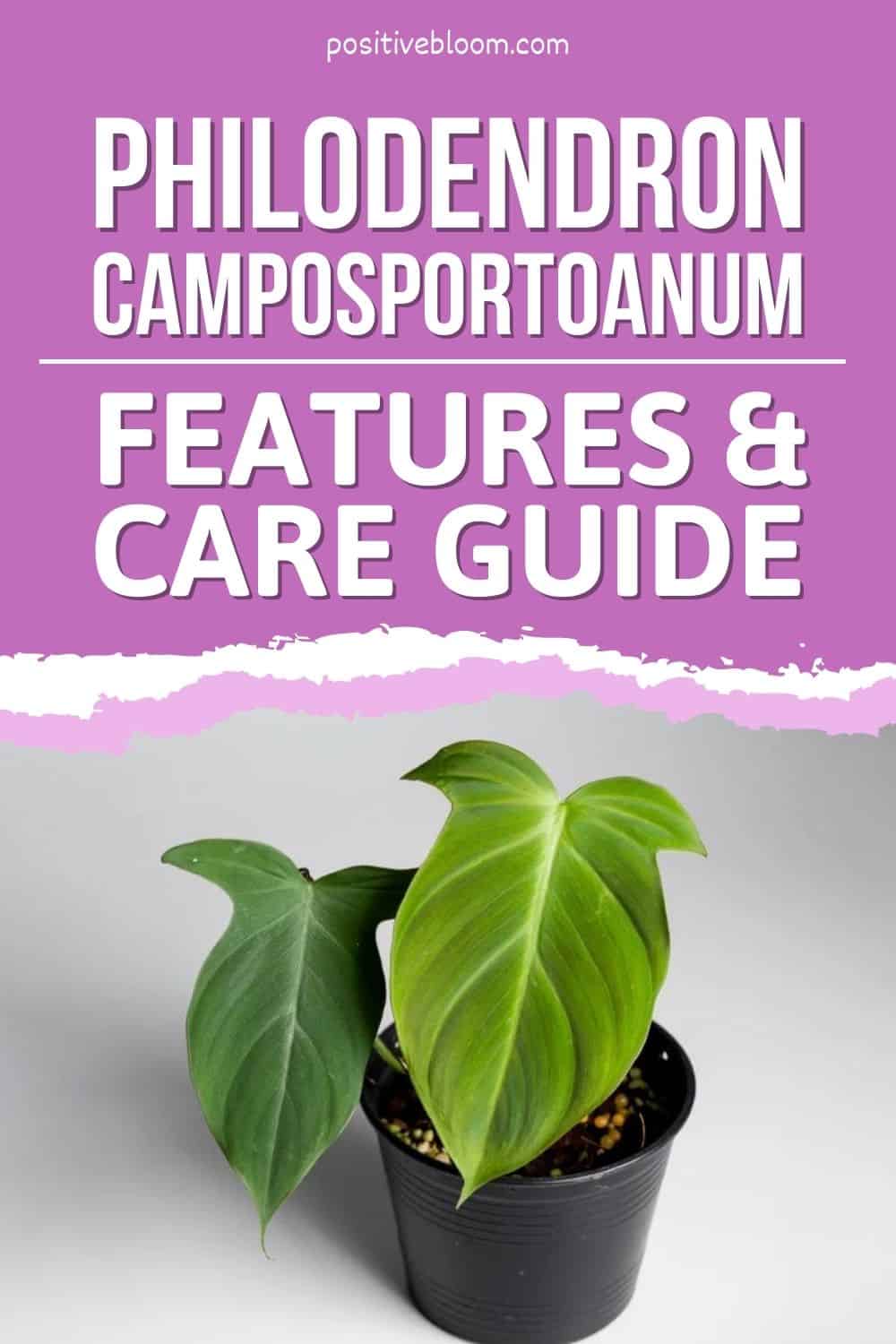One plant, three different leaf shapes? How is that possible?
Well, with the Philodendron Camposportoanum it is!
This popular houseplant produces leaves that have distinctive shapes in different developmental stages; and since your plant is always growing new leaves, you can spot the different shapes all the time.
Not only that, Philodendron camposportoanum is a low-maintenance plant that is also a climber, so you can decorate it in many ways!
To learn more about the Philodendron Camposportoanum regarding its care and common problems, proceed on reading!
Philodendron Camposportoanum Plant Features
The Philodendron Camposportoanum originates from the deep rainforests of Central and South America, particularly Brazil.
It is a rare tropical plant that belongs to the family Araceae, though it is nowadays commonly grown as an indoor plant.
It grows tiny, bright orange leaves at the beginning of growth and they transform into velvety leaves with a much more purple tone; then, they completely change their shape and color into darker shades with a heart-like shape.
As the plant grows, it will develop new leaves and start climbing — at any point, this rare plant will have three differently lobed leaves!
You can take advantage of its climbing ability and get creative by making beautiful trellis and frames.
This beautiful plant is usually grown indoors, however, you can also plant it outside if you live in USDA zones from 11 to 12.
This type of Philodendron species is much smaller when compared to the other, growing only 25 inches tall and 20 inches wide; making it perfect to place on work tables and shelves.
However, take into consideration that it is a climber plant, therefore, it will probably be needing some kind of support whilst growing.
The Philodendron Camposportoanum Care Guide
The Philodendron Camposportoanum is a great plant for all the gardener newbies out there!
All the necessary information in the plant’s care guide is summed up in this table, however, I would recommend that you scroll down and look at the more detailed descriptions of the care guide and be able to provide the best conditions for your plant!
[table id=130 /]Soil Requirements
If this is not your first rodeo with Philodendron plants, then you are probably aware that all Philodendrons, including Philodendron Camposportoanum, thrive in a porous and well-draining soil.
Drainage is important for discharging excess water, and preventing overwatering that usually leads to root rot. Plant your Philodendron Camposportoanum in a pot that contains drainage holes at the bottom.
Porous soil is important for aeration — these types of soil allow oxygen to reach the roots, thus allowing the plant to breathe.
Aside from this, your new plant will require a neutral soil, meaning the pH levels of the soil should be around 7; so you better test your soil before planting!
So, what potting mix would be best for your new Philodendron?
Many growers use a universal mix for Philodendrons, however, I would recommend that you make your own potting soil mixture to provide your plant with all the necessary nutrients for growth and development!
What you’ll need are perlite, sand, sphagnum peat moss, orchid bark, and vermiculite. I often add lime to counteract the high levels of acidity of the sphagnum peat moss.
Temperature Requirements
What other way to create the best possible condition for your plant, than to mimic their natural environment? Being tropical plants, these Philos absolutely love warm temperatures and high humidities!
Let’s talk about temperature first, and then we will track back to humidity.
The Philodendron Camposportoanum does not tolerate temperature fluctuations very well, and thrives the best in a temperature range from 60 to 75 degrees Fahrenheit.
Anything below this will damage your plant, especially frost — keep in mind that Philodendrons are not frost hardy and cannot tolerate low temperatures.
Humidity Requirements
Now let us take a look into humidity, because sometimes it can be tricky to provide the perfect levels of humidity for your tropical plants.
At the end of the day, Philodendrons can survive in environments with lower humidity levels, but I am sure that you want what’s best for your plant, and a higher humidity will also give it that special humidity glow!
The Philodendron Camposportoanum prefers growing in an environment with about 70% humidity levels — it’s a lot, I know, and sometimes it can be difficult to achieve that level in your own home.
Don’t worry, your Philodendron Camposportoanum will grow perfectly normally with humidity levels of around 50%, though it might not have that special humidity glow.
Nonetheless, if you want to provide your plant with the best conditions possible, creating a higher humidity level by yourself should not be that hard — you can always invest in a humidifier, or you can create a pebble tray for your plant.
Pebble Tray Method
To level up your humidity, you can use this simple method that only requires three things: pebbles, a tray, and some water.
First, fill up the tray with pebbles and pour water in it, but make sure that the water does not cover up the pebbles.
The next thing you have to do is simply place your Philodendron Camposportoanum on the top of the tray.
The water will evaporate and create humidity for your plant.
Water Requirements
The Philodendron Camposportoanum slightly differs from other Philodendron species when it comes to watering — it requires a bit more hydration than the others.
Achieving that perfect watering schedule can be difficult sometimes, and most of the time you have to check if the soil has dried out before watering your plant again.
For the majority of Philodendrons, you have to check if a few inches of the soil has dried out; however, for the Philodendron Camposportoanum, you only have to check the topsoil — if it is still slightly moist, then postpone the watering for a few days; if it is completely dry, then you should water the plant.
You will have to water your Philodendron Camposportoanum approximately every four days during summer, and less frequently during the colder seasons when the plant goes dormant.
Overwatering is a common issue in Philodendrons, as it can lead to root rot and eventually the overall destruction of the plant, so bear in mind not to water your Philodendron too often.
Light Requirements
Being a tropical plant, your Philodendron Camposportoanum thrives in bright, indirect sunlight, just like it would when growing under big trees in a rainforest!
Your plant requires 6 to 8 hours of indirect sunlight, though it can tolerate a few hours of direct sunlight early in the morning. But, don’t keep it under the full sun for the rest of the day, as it can burn the leaves!
On the contrary, too little bright light may be the cause of leggy stems. The best placement for your Philodendron Camposportoanum is near to windows that do not get drafty.
Fertilizing Requirements
The best fertilizer for its ideal plant care is a slow-release fertilizer — this way, you won’t have to worry about over fertilizing or under fertilizing.
Your Philodendron Camposportoanum should be fertilized at least once a month during the growing season, so you can promote the development of this trilobed leaf Philodendron Camposportoanum.
You should buy a fertilizer that contains high amounts of nitrogen, as this encourages lush and glossy leaf growth!
Avoid fertilizing it over winter because your plant is not growing, thus it won’t be needing additional nutrients for growth and development.
Pruning
Luckily, pruning is not an essential step of this philodendron care guide, because it would be too hard to trim off those beautiful small leaves for the sake of plant health!
However, if you notice any damaged or infected leaves, then you should definitely remove them to avoid any spreading of a disease.
Repotting
Though these plants are not fast growers, they should be repotted once they have outgrown their initial pot. How do you determine when you should repot your Philodendron Camposportoanum?
Well, you should check the drainage holes at the bottom first, as the little roots of a plant tend to stick out when they no longer have enough space.
Repotting should be done in early spring, and they should be repotted into a pot that is slightly larger than the previous one, because too much additional space increases the susceptibility to pests and diseases, and it might irritate the plant.
Philodendron Camposportoanum Propagation
Photo from@leafingyourbestlife
When it comes to the propagation of this specific philodendron, there are two methods that can be used: stem cutting and air layering.
Both of these methods have positive outcomes, so you can have as many of these rare philodendrons as you want (eventually, they won’t be so rare!).
The air layering method is a safer option, and it involves wrapping sphagnum moss around the wounded area, and waiting for the new roots to grow.
Stem cutting involves cutting off a stem that contains at least two leaves, leaving it to cure for a week and then planting it in an appropriate potting soil.
In both cases, the baby plant should be planted in a pot with drainage holes at the bottom for removal of the excess water.
You can also check out this video:
Air Layering Method
Air layering does not involve completely cutting off the stem, and it is believed that this is the safer option.
In air layering, the growth of new roots is assessed by covering the stem with damp moss.
To successfully propagate your Philodendron Camposportoanum by using the air layering method, carefully follow the instructions below.
1. The first thing you should do is look for an appropriate, healthy stem that contains some aerial roots.
2. Then, you will have to slightly wound the stem — make the cut about two inches deep, using a sterilized knife.
3. You can put a toothpick through the bottom and the top of the wound to make it stay open (it has to be open for the sphagnum moss).
4. The next thing you should do is prepare the sphagnum moss, put it in a plastic bag and add distilled water. The moss should become damp after water addition.
5. Add the sphagnum moss to the wounded area.
6. If it does not stick by itself, then you have to provide some sort of support. You can add string around it to make it stay.
7. Add plastic wrap around the sphagnum moss, and make sure not to wrap it too tightly because it can prevent air circulation, and it needs to breathe so that the new roots can grow out! However, make sure that it is not wrapped too loosely so the sphagnum moss doesn’t fall out. You can add duck tape around the wrap to secure it.
8. Your new baby plant will grow in about three weeks. In the meantime, you could prepare new potting soil and buy a new pot for your plant (make sure that it contains drainage holes at the bottom).
9. When you notice that the roots have grown about 4 inches, it is time to remove the new baby plant from the original plant. Use a sterilized knife or gardening shears, and cut a few inches below the wounded area.
10. Carefully remove the plastic wrap without damaging the new roots. Place it in the already prepared potting soil. You can add fertilizer to boost its growth.
Stem Cutting Method
The stem cutting method is easier when compared to the air layering method. You should propagate your Philodendron Camposportoanum during warmer seasons, from early to late summer.
Here is how you do it:
1. Look for a healthy stem that is about 4 inches long that has at least two leaves. Remove any bottom leaves.
2. Use sterilized gardening equipment and make the cut below the leaf node.
3. Once you have the cutting stem, you should let it cure a bit. Leave it in a place with a warm temperature for a week to promote better growth.
4. In the meantime, you can prepare a new home for your baby plant: buy a pot with drainage holes, and add an appropriate potting soil.
5. After the curing time has passed, it is time to plant the stem cutting. Make a hole that is about 2 inches deep; if you don’t mind getting your hands a bit dirty, you can make the hole by penetrating the soil with two fingers.
6. Once you place the cutting in the hole, pack the soil around it to make it more compact. From now on, you can treat your new Philodendron Camposportoanum as you would treat a regular Philodendron plant.
Philodendron Camposportoanum Common Problems
Photo from@verdure.sur.la.4e
Even though this plant seems perfect for beginner growers, there are still some issues that you might need to deal with in the future!
Not only is the Philodendron Camposportoanum toxic, but it is also susceptible to some pests and diseases.
Read on to find out about the common problems of this Philodendron species.
Toxicity
The Philodendron Camposportoanum is unfortunately toxic to pets and humans, so you have to be extra careful and keep the little ones away from your plant!
If ingested, this plant can cause vomiting, swelling and burning sensation in the mouth.
I would recommend that you call doctors/veterinarians if your kids or pets have accidentally taken a bite of the plant.
Browning Leaves
The leaves or tips of the leaves turning brown might be signs of two issues: sunburn and under watering.
If you have put your Philodendron Camposportoanum in a place that is exposed to direct sunlight throughout the day, then the issue might be sunburn.
Remember that this type of Philodendron thrives in bright, indirect sunlight.
However, if you have skipped watering your plant for a while, then the issue might be under watering. If the soil of your plant is completely dried out, then, you get the gist. Water your plant as soon as possible!
Pests & Diseases
The Philodendron Camposportoanum is a low-maintenance plant, mainly because it is resistant to many pests: I said many, not all.
This plant is prone to white flies, mealybugs and spider mites.
If you notice any discoloration of its leaves or stunted growth, then you might be dealing with pest infestations.
Your Philodendron Camposportoanum is especially susceptible to spider mites, which create yellow spots and webs on the leaves. They love munching on those beautiful leaves and stealing all the plant’s nutrients!
To fight them off, you should spray neem oil or use insecticide. Another natural solution would be to introduce ladybugs to your plant, as they are known for being spider mite destroyers.
Root Rot
When you overwater your plant, the soil becomes soggy and attracts fungus and bacteria. This leads to root rot, which is caused by a fungal infection.
If you notice any stunted growth or yellowing and wilting of the leaves, then you might be dealing with root rot.
You can repot your plant and remove the rotten roots by cutting them with sterile gardening scissors.
Pale Leaves
If you notice that the leaves of your Philodendron Camposportoanum look paler than usual, there might be a few reasons for that.
First, you might be over watering your plant, or there are not enough nutrients for it to fully develop, specifically a nitrogen deficiency. Another reason might be overly exposure to direct sunlight.
If you were doing any of these, or God forbid all three — read the care guide again, and provide the best conditions for your plant!
Plant Drooping
If you notice that your Philodendron Camposportoanum looks kind of leggy or droopy, then it probably is not receiving enough indirect sunlight.
Put your Philodendron in a place with enough indirect and bright light, near a window that does not get direct sunlight throughout the day.
You should also rotate your plant so that every side gets enough sunlight.
Frequently Asked Questions
1. Is the Philodendron Camposportoanum a Micans?
Even though these two plants have an astonishing resemblance, the Philodendron Camposportoanum and Philodendron Micans are not the same plant.
They do belong to the same family, however, they are two different species.
The difference is the sheen of the leaves: the Philodendron Camposportoanum has a more orange sheen, while the Philodendron Micans has a subtle purple sheen.
2. What is the best environment for a Philodendron Camposportoanum?
The best environment for a Philodendron Camposportoanum is one that is mimicking their natural habitat: put them in bright, indirect sunlight, provide them with a well-draining and slightly moist soil and add nitrogen-containing fertilizers during the growing season.
Keep the temperature in a range of 60 to 75 degrees Fahrenheit, and the humidity levels should be around 70%. Water the plant when the top of the soil is dried out, and prune it when needed.
3. Is the Philodendron Camposportoanum rare?
This type of Philodendron has been proclaimed as a rare species, although nowadays it has become quite popular among the plant enthusiast community!
Being a rare plant, the Philodendron Camposportoanum is a bit pricey when compared to other Philodendrons such as Imperial Green Philodendron or Lickety Split.
Final Thoughts
This rare Philodendron species has become a popular houseplant nowadays, mainly because of the unique shapes and colors of the leaves through different developmental stages that are simply breathtaking!
Not only is the Philodendron Camposportoanum the perfect plant for home decor, but it is also easy to take care of, which is why every beginner gardener must try growing one and practicing his/her gardening skills.
The care is quite similar to the rest of the Philodendrons: keep the soil moist and well-drained, put them in bright and indirect sunlight, use fertilizers once a month during the growing seasons and keep the temperature and humidity high.
Bear in mind that this Philodendron plant needs a bit more hydration when compared to the other types — make sure to water it when the top of the soil dries out.
You can propagate it either by air layering or stem cutting — it is completely up to you!
Until next time!
Like this post? Share or pin it for later!

